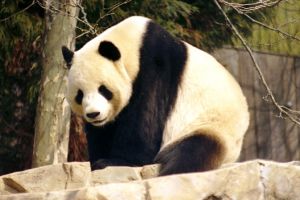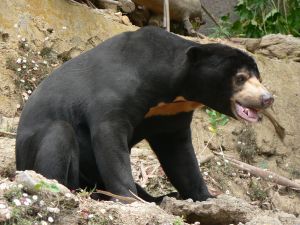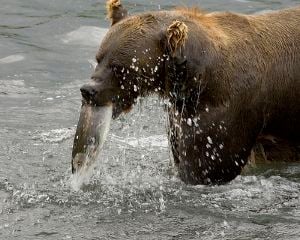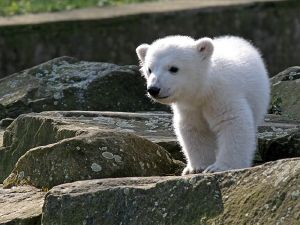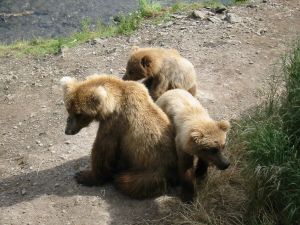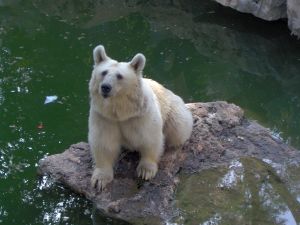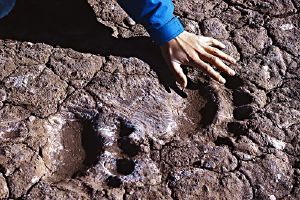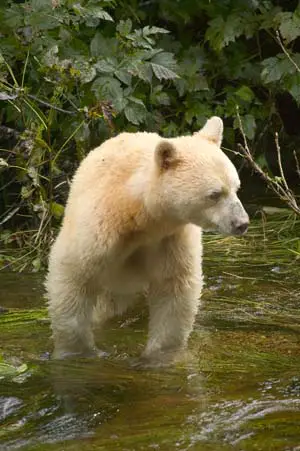Difference between revisions of "Bear" - New World Encyclopedia
(→Politics and culture: uncited, seemingly not notable, and a bit negative as well) |
Rosie Tanabe (talk | contribs) |
||
| (28 intermediate revisions by 4 users not shown) | |||
| Line 1: | Line 1: | ||
| − | {{ | + | {{Copyedited}}{{Approved}}{{Images OK}}{{Submitted}}{{Paid}} |
| − | + | {{Taxobox | |
| − | + | | color = pink | |
| − | + | | name = Bear | |
| − | + | | fossil_range = Early [[Miocene]] - Recent | |
| − | + | | image = Kodiak_Brown_Bear.jpg | |
| − | + | | image_width = 240px | |
| − | + | | image_caption = ''Kodiak Brown Bear'' | |
| − | + | | regnum = [[Animal]]ia | |
| − | + | | phylum = [[Chordate|Chordata]] | |
| − | '' | + | | classis = [[Mammal]]ia |
| − | '' | + | | ordo = [[Carnivora]] |
| − | '' | + | | subordo = Caniformia |
| − | '' | + | | superfamilia = Ursoidea |
| − | '' | + | | familia = '''Ursidae''' |
| − | '' | + | | familia_authority = [[Johann Fischer von Waldheim|G. Fischer de Waldheim]], 1817 |
| − | '' | + | | subdivision_ranks = Genera |
| − | + | | subdivision = | |
| − | + | ''Ailuropoda''<br /> | |
| + | ''Helarctos''<br /> | ||
| + | ''Melursus''<br /> | ||
| + | ''Ursavus'' "true bear" <br /> | ||
| + | ''Ursus''<br /> | ||
| + | ''Tremarctos''<br /> | ||
| + | ''Agriarctos'' (extinct)<br /> | ||
| + | ''Amphicticeps'' (extinct)<br /> | ||
| + | ''Amphicynodon'' (extinct)<br /> | ||
| + | ''Arctodus'' (extinct)<br /> | ||
| + | ''Cephalogale'' (extinct)<br /> | ||
| + | ''Indarctos'' (extinct)<br /> | ||
| + | ''Parictis'' (extinct)<br /> | ||
| + | ''Plionarctos'' (extinct) | ||
| + | }} | ||
| + | '''Bear''' is the common name for any of the [[mammal]]s comprising the [[family (biology)|family]] '''Ursidae''' of the [[Carnivora]] order, characterized by a large and heavy body, thick [[fur]], relatively short but stocky legs, and short tails. There are only eight living [[species]] of bear; however, they are widespread, appearing in a wide variety of [[habitat]]s in most of the [[Northern Hemisphere]] and partially in the [[Southern Hemisphere]]. Although carnivores in the sense of being members of the order Carnivora, living species of bears typically have an omnivorous diet. | ||
| − | + | Bear provide many values to humans. Historically, they have provided meat and fur and in traditional cultures a high spiritual importance was placed on bears. And, whether in the wild, in [[zoo]]s, or in art, they add greatly to the human wonder of nature. Despite such values, and the common religious view of humans as stewards of creation, bears sometimes have suffered greatly at the hands of humans. This is particularly evident in the captivity and harvesting of bears for body parts and secretions for [[traditional Chinese medicine]]—a practice that can include pushing a stick into a captive bear's abdomen to collect the seeping [[bile]] from a open wound, or starving them to death for their paws and [[gallbladder]]s, used as delicacies. | |
| − | + | ==Etymology== | |
| + | Modern English "''bear''" derives from [[Old English]] "''bera''," which itself derives from Proto-Germanic "''*beron''" meaning "''the brown one''." (Compare [[Swedish language|Scandinavian]] "''björn''," [[Dutch language|Dutch]] "''beer''," [[German language|Standard German]] "''Bär''"—all meaning "''bear''.") | ||
| − | + | Both [[Greek language|Greek]] ("''arktos''") and [[Latin]] ("''ursus''") have retained the [[Proto-Indo-European language|Proto-Indo-European]] root word for "bear" ("''*rtko''"), but it was ritually replaced in the northern branches of the [[Indo-European languages]] (the [[Germanic languages|Germanic]], [[Baltic languages|Baltic]], [[Celtic languages|Celtic]], and [[Slavic languages|Slavic]] branches) because of the hunters' [[taboo]] on the names of wild animals. For example the [[Irish language|Irish]] word for "''bear''" translated means "''the good calf''," in [[Welsh language|Welsh]] it translates as "''honey-pig''," in [[Lithuanian language|Lithuanian]] it means "''the licker''," and in [[Russian language|Russian]] "''медведь''" literally means "''honey-wise''." | |
| − | + | In [[English language|English]], the adjective '''''ursine''''' is used to describe things of a bear-like nature, while the [[English collective nouns|collective noun]] for a group of them is a ''sleuth''. Male bears are called '''boars''', females '''sows''', and young bears '''cubs'''. | |
| − | + | ==Characteristics== | |
| − | + | Bears are among the largest land carnivores (members of the order [[Carnivora]]), along with the [[lion]] and the [[tiger]]. Unlike these big [[cat]]s, however, bears do not depend on hunting and killing other animals (with the exception of the polar bear). As omnivores, bears are able to take advantage of a wide variety of foodstuffs as they encounter them. The giant [[panda]] has a largely vegetarian diet, although it will also eat [[egg (animal)|eggs]] and [[fish]]. | |
| − | + | Bears walk on all four feet but can stand up on their hind feet. They often do this to get a better view or to appear larger to potential rivals. Like humans, bears walk on the flats of their feet, unlike [[dog]]s and [[cat]]s which walk on their toes. Each foot has five large claws which are used to dig for food, to catch prey, and to fight against predators and other bears. The bears' heads are massive and their canine teeth are long, while their molars are more flattened than other carnivores. Because of their strength and large size, bears are not often preyed upon by other carnivores (Nowak 1983; Ward 1995). | |
| − | + | Bears' [[eyesight]] and [[hearing]] are not especially acute. [[Smell]] is their best sense. Polar bears have been known to detect rotting meat 16 kilometers (10 miles) away (Nowak 1983; Voelker 1986). | |
| − | Bears | ||
| − | + | Bears are covered with thick [[fur]], which protects them in the severe cold that most species encounter in their habitats. The polar bear, brown bear, and American black bear have solid color coats. The sun bear, sloth bear, spectacled bear, and Asiatic black bear have dark coats with light patterns on the chest and face. The giant panda has a distinctive, and famous, black and white "patchwork" coat. All bears have short [[tail]]s (Nowak 1983; Ward 1995). | |
| − | Bears | ||
| − | + | Most bears live in [[forest]]s or semi-wooded areas, with the exception of the polar bear. They often climb [[tree]]s (except for the brown bear and the polar bear) to find food and to escape from danger. Bears require a good supply of food and water so they are not found in [[desert]] areas. They are found in tropical [[rainforest]]s, in temperate forests, in high [[mountain]]s, in [[Grass|grasslands]], in the [[tundra]], and on the Arctic ice (polar bears). | |
| − | |||
| − | |||
| − | === | + | ==Living species== |
| − | The | + | ===Giant panda=== |
| + | [[Image:Giant Panda 2004-03-2.jpg|thumb|Giant panda.]] | ||
| + | The [[Panda|giant panda]] ''(Ailuropoda melanoleuca)'' is almost completely vegetarian. About 99 percent of its diet is [[bamboo]]. About 30 different species of bamboo are eaten. Pandas sometimes eat other [[plant]]s, as well as small [[animal]]s. Because bamboo is low in usable energy, pandas must spend around 12 hours each day eating. Pandas are medium-sized for bears, weighing from 75 to 160 kg (165 to 350 lbs). They are found only in a few places in [[China]] and are now extremely [[endangered species|endangered]], with only a few hundred left in the wild (Nowak 1983; Voelker 1986; Ward 1995; IUCN 2007). | ||
| − | === | + | ===Spectacled bear=== |
| − | + | The spectacled bear ''(Tremarctos ornatus)'' is a medium-sized bear, 60 to 150 kg (130 to 330 lbs), found in the [[mountain]]ous regions of northwest [[South America]]. It is mainly vegetarian, up to 90 percent or more of its diet consists of [[fruit]] and other [[plant]] materials, especially [[bromoeliad]]s, which are common in its habitat. The spectacled bear is hunted for its meat and [[fur]] and because it sometimes eats [[corn]] and other crops. Loss of habitat is also a problem and its population may be declining (Nowak 1983; Ward 1995; IUCN 2007). | |
| − | + | ===Sloth bear=== | |
| + | The sloth bear ''(Melursus ursinus)'' is found throughout [[India]] and [[Sri Lanka]]. It is a medium-sized bear weighing 55 to 145 kg (120 to 320 lbs). It mainly feeds on [[termite]]s, which it sucks out of their nests with a vacuum cleaner-like action. It also feeds on [[plant]] foods, [[honey]], and carrion. The sloth bear is threatened both by hunting and by conversion of its habitat to farm land (Nowak 1983; Ward 1995; IUCN 2007). | ||
| − | + | ===Sun bear=== | |
| − | The bear | + | [[Image:Sun Bear, Pengo.jpg|thumb|left|Sun bear]] |
| + | The sun bear ''(Helarctos malayanus)'' is the smallest bear, weighing 27 to 65 kg (60 to 145 lbs). It is found in [[Southeast Asia]], including the islands of [[Borneo]] and [[Sumatra]]. The sun bear is the most arboreal bear and builds sleeping nests as high as 18 meters (60 feet) in the [[tree]]s. It eats mainly [[insect]]s and [[earthworm]]s, along with some [[fruit]] and small animals. Habitat destruction and hunting seem to be lowering its numbers (Nowak 1983; Voelker 1986; Ward 1995; IUCN 2007). | ||
| − | == | + | ===Asiatic black bear=== |
| − | + | The Asiatic black bear ''(Ursus thibetanus)'' is found across a wide area of eastern [[Asia]] from [[Afghanistan]] to [[Vietnam]] to northeastern [[China]], including [[Taiwan]] and the [[Japan]]ese islands of [[Honshu]] and [[Shikoku]]. It is medium-sized, with females weighing 50 to 125 kg (110 to 275 lbs) and males 100 to 200 kg (220 to 440 lbs). Its diet varies over its range, but it mostly depends on plant foods, especially [[fruit]]s and [[nut]]s. It eats [[insect]]s and larger animals as well and has been know to prey on domestic animals, killing animals as large as adult [[Buffalo|water buffalo]]. The Asiatic black bear is suffering from human encroachment on its territory and is often hunted illegally (Nowak 1983; Ward 1995; IUCN 2007). | |
| − | + | ===American black bear=== | |
| + | The American black bear ''(Ursus americanus)'' is now the most numerous bear in the world. It is found in [[North America]] from [[Florida]] to [[Alaska]], although not in all areas of the continent. It occupies a wide range of habitats, from southern [[forest]]s to northern [[tundra]], and is also found in a range of colors from black to brown to yellow to white. It is medium-sized to large with females weighing 90 to 140 kg (200 to 310 lbs) and males 115 to 270 kg (255 to 600 lbs). Its diet is varied but mostly consists of plant materials over most of its range. The American black bear is doing well and probably increasing in number because of its ability to adapt to different environments and due to protection from excessive hunting in its range (Nowak 1983; Ward 1995; IUCN 2007). | ||
| − | The brown bear is [[ | + | ===Brown bear=== |
| + | [[Image:Brown Bear Feeding on Salmon 1.jpg|thumb|left|Brown bear feeding on salmon.]] | ||
| + | The brown bear, or grizzly bear, ''(Ursus arctos)'' is a large bear, although its weight varies between local populations. The Kodiak bear of [[Alaska]]'s [[Kodiak Islands]] is the largest subspecies of brown bear, weighing as much as 700 kg (1500 lbs), while the brown bears of the southern European mountains average about 70 kg (150 lbs). Brown bears are found from western [[North America]], across northern [[Asia]] (including the [[Japan]]ese island of [[Hokkaido]]), and in parts of [[Europe]]. Their diet varies with the season and the area. Plant foods make up most of their diet although they also hunt animals as large as [[moose]], [[elk]], and [[bison]]. In some areas, migrating [[salmon]] are an important food source during the crucial time in autumn when they need to put on weight for the winter. [[Insect]]s are also eaten. Brown bears prefer a more open habitat than black bears and in the past were common on the [[Great Plains]] of North America. Brown bears are protected from excessive hunting over most of their range and are doing well in most places (Nowak 1983; Ward 1995; IUCN 2007). | ||
| − | [[ | + | ===Polar bear=== |
| + | [[Image:Knut IMG 8095.jpg|thumb|Polar bear cub]] | ||
| + | The polar bear ''(Ursus maritimus)'' is the largest bear with females weighing 150 to 300 kg (330 to 660 lbs) and males 300 to 800 kg (660 to 1765 lbs). The largest bear ever recorded was a male polar bear, which stood 3.35 meters (11 ft) tall and weighed 1000 kg (2200 lbs). Polar bears live throughout the [[Arctic]] and range far out to sea on the sea ice. Their diet is mainly the ringed [[seal]] ''(Phoca hispida)'', which they catch through the ice. In areas where the ice melts in summer they eat some [[berry|berries]] and other plant foods during this time. They also eat other sea mammals, [[fish]], and carrion. Polar bears are doing well now but some have expressed concern about the potential for [[global warming]] to cause reduction in the sea ice of the [[Arctic Ocean]]. It is possible that they will be [[extinction|extinct]] in the wild within the twenty-first century (Nowak 1983; Voelker 1986; Ward 1995; IUCN 2007). | ||
| − | == | + | ==Behavior== |
| − | + | [[Image:Katmai Sow and Cubs.JPG|thumb|Brown bear mother and cubs.]] | |
| − | + | Bears spend most of their time sleeping, looking for food, or feeding. | |
| − | |||
| − | |||
| − | |||
| − | |||
| − | |||
| − | |||
| − | |||
| − | |||
| − | |||
| − | |||
| − | |||
| − | |||
| − | |||
| − | |||
| − | |||
| − | |||
| − | |||
| − | |||
| − | |||
| − | |||
| − | |||
| − | |||
| − | |||
| − | |||
| − | |||
| − | |||
| − | |||
| − | |||
| − | |||
| − | |||
| − | |||
| − | |||
| − | |||
| − | |||
| − | |||
| − | |||
| − | |||
| − | |||
| − | + | Most bears living in northern areas go into a period of deep sleep in the winter. This is often called [[hibernation]], but it is not as deep as the true hibernation of some [[rodent]]s—during a bear's winter sleep state, the degree of [[metabolism|metabolic]] depression is much less than what is observed in smaller mammals. Many prefer to use the term "denning" in place of hibernating. The black bear's body temperature remains relatively stable (depressed from 37°C to approximately 31°C) and it can be easily aroused. In contrast, hibernating ground [[squirrel]]s may have core body temperatures as low as -2° C. Still, there is much debate about this within the scientific community; some feel that black bears are true hibernators that employ a more advanced form of hibernation. During this [[dormancy]] period, which can be as long a six months, bears depend on stored body [[fat]] to provide the energy they need to stay alive. Bears often dig a den into the ground for a warm and protected sleeping place, or they use natural [[cave]]s or hollow [[tree]]s. | |
| − | + | In order to build up the fat supply they need, bears have to eat a great deal of [[nutrition|nutritious]] food during the summer and autumn. Because of the low nutritional value of their [[bamboo]] diet, giant pandas do not go into a winter sleep. Bears living in warm climates also do not deep sleep since food is available for them year round. Male polar bears generally stay active through the winter, while females den up to have their cubs. | |
| − | + | Unlike some other [[Carnivora|carnivores]], such as members of the [[Canidae|dog family]], bears are not social animals. Adult bears do not live together or cooperate to find food or defend each other. Exceptions are the Asiatic brown bear and the sloth bear, which sometimes live in family groups. Brown bears and polar bears also sometimes come together in larger groups to take advantage of a food source, but do not cooperate with each other (Voelker 1986). | |
| − | + | [[Image:Inspecting Newborn Black Bear Cubs.jpg|thumb|left|Newborn American black bear cubs]] | |
| + | The bear's courtship period is very brief. Bears reproduce seasonally. In northern species, the cubs are born during the winter sleep time. Cubs are born toothless, blind, and bald. The cubs of brown bears, usually born in litters of 1 to 3, will typically stay with the mother for two full seasons. They feed on their mother's milk through the duration of their relationship with their mother, although as the cubs continue to grow, nursing becomes less frequent and they learn to begin hunting with the mother. They will remain with the mother for approximately three years, until she enters the next cycle of estrus and drives the cubs off. Bears will reach sexual maturity in five to seven years. | ||
| − | + | ==Bears and humans== | |
| + | In many places, bears and humans live in the same areas, and sometimes share the same food resources. This sometimes leads to conflicts. Even the smallest adult bear is capable of killing an unarmed human and bear attacks on humans do happen. Between 1965 and 1985, six people were killed in [[Canada]] by polar bears. Between 1900 and 1980, 23 people were killed in [[North America]] by American black bears and about twice as many by brown bears (grizzly bears). It seems that the brown bears were mostly females defending their cubs, while the polar bears and black bears were acting as predators (Kruuk 2002). Bears also prey on domestic animals and forage on crops. They break into beehives and into homes to find food. They sometimes also come into conflict with human interests when they damage [[tree]]s by stripping off the bark to eat the inner layers (Ward 1995). | ||
| − | + | Many traditional cultures in the northern regions of [[Europe]], [[Asia]], and North America place a high importance on bears. They often are seen to have supernatural powers and in many places rituals developed centering on the hunting of bears. Often the spirit of the bear that is killed is considered to be a messenger sent to the [[spirit world]] on behalf of the community. The Greek goddess [[Artemis]] and the English hero [[King Arthur]] both take their names from the Indo-European word for bear (Ward 1995). [[Korean mythology]] identifies the bear as the ancestor and symbolic animal of the Korean people. The [[constellation]]s Ursa Major and Ursa Minor represent bears. | |
| − | + | Bears have also long been hunted for their meat and [[fur]]. Their meat is dark and stringy, like a tough cut of beef. In [[Cantonese cuisine]], bear paws are considered a delicacy. | |
| − | + | The peoples of [[China]], [[Japan]], and [[Korea]] use bears' body parts and secretions (notably their [[gallbladder]]s and [[bile]]) as part of [[traditional Chinese medicine]]. Bear bile contains ursodeoxycholic acid (UDCA), which is believed by practitioners to reduce [[fever]], protect the [[liver]], remedy [[kidney]] aliments, improve eyesight, break down gallstones, and act as an anti-inflammatory. It is more common in bear bile than in other animals. Although there is an international ban on trade in bear parts, bear farms exist in China and [[Vietnam]] for extraction of bile. These farms are reported to involve a great deal of cruelty for the animals, with bears being kept in small cages and having a tube or metal inserted to capture bile from the gallbladder, or by allowing it to seep freely from an open wound created by pushing a hollow steel stick though the bear's abdomen. When they stop producing, bears have been left to starve to death or killed for their paws and gallbladders, both of which are considered delicacies. It is believed more than 12,000 bile bears are kept on farms, farmed for their bile, in China, Vietnam, and [[South Korea]] (Black 2007). | |
| − | |||
| − | |||
| − | In | + | Captive bears are also exhibited in [[zoo]]s and circuses. In the past they were used in cruel sports in which they were forced to fight against dogs and other animals. |
| + | |||
| + | Bears have often been used as [[totem]]s and symbols. The [[Germany|German]] city of [[Berlin]] and the [[Switzerland|Swiss]] city of [[Bern]] are named after the bear and feature bears on their coats of arms. The brown bear is [[Finland]]'s national animal. In the [[United States]], the black bear is the state animal of [[Louisiana]], [[New Mexico]], and [[West Virginia]]; the grizzly bear is the state animal of both [[Montana]] and [[California]]. | ||
| − | + | Bears are popular as characters in children's stories and are often featured in art. The [[teddy bear]], named after United States President [[Theodore Roosevelt|Theodore ("Teddy") Roosevelt]], has become one of the world's most popular [[toy]]s. | |
| − | == | + | ==Classification== |
| − | + | [[Image:Brown-bear-biblica-zoo.jpg|right|thumb|A Syrian (Brown) Bear in the Jerusalem Biblical Zoo]] | |
| − | + | [[Image:Polarbeartrack-1.jpg|thumb|Polar bear tracks]] | |
| − | * | + | [[Image:Spiritbear.jpg|thumb|Kermode bear (American black bear)]] |
| − | * | + | * '''Family Ursidae''' |
| − | * | + | ** '''Subfamily Ailuropodinae''' |
| − | * | + | *** [[Giant Panda]], ''Ailuropoda melanoleuca'' |
| − | * | + | *** Dwarf Panda, ''Ailuropoda minor'' (extinct) |
| − | + | ** '''Subfamily Agriotherinae''' | |
| − | + | *** Agriotherium (extinct) | |
| − | * | + | **** ''Agriotherium inexpectans'' (extinct) |
| − | * | + | **** ''Agriotherium sivalensis'' (extinct) |
| − | * | + | **** ''Agriotherium roblesi'' (extinct) |
| − | * | + | **** ''Agriotherium africanum'' (extinct) |
| − | * | + | ** '''Subfamily Tremarctinae''' |
| − | * | + | *** [[Spectacled Bear]], ''Tremarctos ornatus'' |
| − | + | *** Florida Cave Bear, ''Tremarctos floridanus'' (extinct) | |
| − | + | *** Giant Short-Faced Bear, ''Arctodus simus'' (extinct) | |
| − | * | + | *** Short-Faced Bear, ''Arctodus pristinus'' (extinct) |
| − | * | + | *** Brazilian Short-Faced Bear, ''Arctotherium brasilense'' (extinct) |
| − | + | *** Argentine Short-Faced Bear, ''Arctotherium latidens'' (extinct) | |
| − | + | **'''Subfamily Ursinae''' | |
| − | * | + | *** [[Brown Bear]], ''Ursus (Ursus) arctos'' |
| − | + | **** Syrian (Brown) Bear ''Ursus arctos syriacus'' | |
| − | + | **** Grizzly Bear, ''Ursus arctos horribilis'' | |
| − | + | **** Kodiak Bear, ''Ursus arctos middendorffi'' | |
| − | + | **** Himalayan Brown Bear, ''Ursus arctos isabellinus'' | |
| − | * | + | **** Bergman's Bear, ''Ursus arctos piscator'' (extinct?) |
| − | *'' | + | **** Atlas Bear, ''Ursus arctos crowtheri'' (extinct) |
| − | + | *** [[American black bear|American Black Bear]], ''Ursus (Ursus) americanus'' | |
| − | + | **** Cinnamon Bear, ''Ursus americanus cinnamomum'' | |
| − | * | + | **** Kermode Bear, ''Ursus americanus kermodie'' |
| − | * | + | *** [[Polar Bear]], ''Ursus (Thalarctos) maritimus'' |
| − | * | + | *** [[Asiatic Black Bear]], ''Ursus (Selenarctos) thibetanus'' |
| − | *[[ | + | **** Formosan Black Bear, ''Ursus thibetanus formosanus'' |
| − | *[[ | + | **** ''Ursus thibetanus gedrosianus'' |
| − | *[[ | + | **** ''Ursus thibetanus japonica'' |
| − | * | + | **** ''Ursus thibetanus laniger'' |
| − | + | **** ''Ursus thibetanus mupinensis'' | |
| − | + | **** ''Ursus thibetanus thibetanus'' | |
| − | * | + | **** ''Ursus thibetanus ussuricu'' |
| − | * | + | *** [[Sloth Bear]], ''Melursus ursinus'' |
| − | * | + | **** [[Sri Lankan Sloth Bear]] ''Melursus ursinus inornatus'' |
| − | * | + | **** [[Indian Sloth Bear]] ''Melursus ursinus ursinus'' |
| − | * | + | *** [[Sun Bear]], ''Helarctos malayanus'' |
| − | *[ | + | **** Borneo Sun Bear ''Helarctos malayanus euryspilus'' |
| − | + | *** Auvergne Bear, ''Ursus minimus'' (extinct) | |
| − | + | *** Etruscan Bear, ''Ursus etruscus'' (extinct) | |
| + | *** [[Cave Bear|European Cave Bear]], ''Ursus spelaeus'' (extinct) | ||
| + | The genera ''Melursus'' and ''Helarctos'' are sometimes also included in ''Ursus''. The Asiatic black bear and the polar bear used to be placed in their own genera, ''Selenarctos'' and ''Thalarctos'', which are now placed at subgenus rank. | ||
| + | ==References== | ||
| + | * Black, R. 2007. [http://news.bbc.co.uk/2/hi/science/nature/6742671.stm Test kit targets cruel bear trade]. ''BBC News''. Retrieved August 16, 2007. | ||
| + | * International Union for Conservation of Nature and Natural Resources (IUCN). 2007. [http://www.iucnredlist.org/search/details.php/712/summ ''"Ailoropoda melanoleuca"''], [http://www.iucnredlist.org/search/details.php/9760/summ ''"Helarctos malayanus"''], [http://www.iucnredlist.org/search/details.php/13143/summ ''"Melursus ursinus"''], [http://www.iucnredlist.org/search/details.php/22066/summ ''"Tremarctos ornatus"''], [http://www.iucnredlist.org/search/details.php/41687/summ ''"Ursus americanus"''], [http://www.iucnredlist.org/search/details.php/41688/summ ''"Ursus arctos"''], [http://www.iucnredlist.org/search/details.php/22823/summ ''"Ursus maritimus"''], [http://www.iucnredlist.org/search/details.php/22824/summ ''"Ursus thibetanus"'']. ''International Union for the Conservation of Nature and Natural Resources''. Retrieved August 15, 2007. | ||
| + | * Kruuk, H. 2002. ''Hunter and Hunted: Relationships between Carnivores and People.'' Cambridge, UK: Cambridge University Press. ISBN 0521814103. | ||
| + | * Nowak, R. M., and J. L. Paradiso. 1983. ''Walker's Mammals of the World''. Baltimore: Johns Hopkins University Press. ISBN 0801825253. | ||
| + | * Voelker, W. 1986. ''The Natural History of Living Mammals''. Medford, NJ: Plexus Publishing. ISBN 0937548081. | ||
| + | * Ward, P., and S. Kynaston. 1995. ''Wild Bears of the World''. New York: Facts on File. ISBN 0816032459. | ||
| − | + | {{credit|Bear|149968783}} | |
Latest revision as of 05:14, 17 November 2019
| Bear
| ||||||||||||||
|---|---|---|---|---|---|---|---|---|---|---|---|---|---|---|
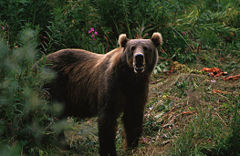 Kodiak Brown Bear
| ||||||||||||||
| Scientific classification | ||||||||||||||
| ||||||||||||||
|
Ailuropoda |
Bear is the common name for any of the mammals comprising the family Ursidae of the Carnivora order, characterized by a large and heavy body, thick fur, relatively short but stocky legs, and short tails. There are only eight living species of bear; however, they are widespread, appearing in a wide variety of habitats in most of the Northern Hemisphere and partially in the Southern Hemisphere. Although carnivores in the sense of being members of the order Carnivora, living species of bears typically have an omnivorous diet.
Bear provide many values to humans. Historically, they have provided meat and fur and in traditional cultures a high spiritual importance was placed on bears. And, whether in the wild, in zoos, or in art, they add greatly to the human wonder of nature. Despite such values, and the common religious view of humans as stewards of creation, bears sometimes have suffered greatly at the hands of humans. This is particularly evident in the captivity and harvesting of bears for body parts and secretions for traditional Chinese medicine—a practice that can include pushing a stick into a captive bear's abdomen to collect the seeping bile from a open wound, or starving them to death for their paws and gallbladders, used as delicacies.
Etymology
Modern English "bear" derives from Old English "bera," which itself derives from Proto-Germanic "*beron" meaning "the brown one." (Compare Scandinavian "björn," Dutch "beer," Standard German "Bär"—all meaning "bear.")
Both Greek ("arktos") and Latin ("ursus") have retained the Proto-Indo-European root word for "bear" ("*rtko"), but it was ritually replaced in the northern branches of the Indo-European languages (the Germanic, Baltic, Celtic, and Slavic branches) because of the hunters' taboo on the names of wild animals. For example the Irish word for "bear" translated means "the good calf," in Welsh it translates as "honey-pig," in Lithuanian it means "the licker," and in Russian "медведь" literally means "honey-wise."
In English, the adjective ursine is used to describe things of a bear-like nature, while the collective noun for a group of them is a sleuth. Male bears are called boars, females sows, and young bears cubs.
Characteristics
Bears are among the largest land carnivores (members of the order Carnivora), along with the lion and the tiger. Unlike these big cats, however, bears do not depend on hunting and killing other animals (with the exception of the polar bear). As omnivores, bears are able to take advantage of a wide variety of foodstuffs as they encounter them. The giant panda has a largely vegetarian diet, although it will also eat eggs and fish.
Bears walk on all four feet but can stand up on their hind feet. They often do this to get a better view or to appear larger to potential rivals. Like humans, bears walk on the flats of their feet, unlike dogs and cats which walk on their toes. Each foot has five large claws which are used to dig for food, to catch prey, and to fight against predators and other bears. The bears' heads are massive and their canine teeth are long, while their molars are more flattened than other carnivores. Because of their strength and large size, bears are not often preyed upon by other carnivores (Nowak 1983; Ward 1995).
Bears' eyesight and hearing are not especially acute. Smell is their best sense. Polar bears have been known to detect rotting meat 16 kilometers (10 miles) away (Nowak 1983; Voelker 1986).
Bears are covered with thick fur, which protects them in the severe cold that most species encounter in their habitats. The polar bear, brown bear, and American black bear have solid color coats. The sun bear, sloth bear, spectacled bear, and Asiatic black bear have dark coats with light patterns on the chest and face. The giant panda has a distinctive, and famous, black and white "patchwork" coat. All bears have short tails (Nowak 1983; Ward 1995).
Most bears live in forests or semi-wooded areas, with the exception of the polar bear. They often climb trees (except for the brown bear and the polar bear) to find food and to escape from danger. Bears require a good supply of food and water so they are not found in desert areas. They are found in tropical rainforests, in temperate forests, in high mountains, in grasslands, in the tundra, and on the Arctic ice (polar bears).
Living species
Giant panda
The giant panda (Ailuropoda melanoleuca) is almost completely vegetarian. About 99 percent of its diet is bamboo. About 30 different species of bamboo are eaten. Pandas sometimes eat other plants, as well as small animals. Because bamboo is low in usable energy, pandas must spend around 12 hours each day eating. Pandas are medium-sized for bears, weighing from 75 to 160 kg (165 to 350 lbs). They are found only in a few places in China and are now extremely endangered, with only a few hundred left in the wild (Nowak 1983; Voelker 1986; Ward 1995; IUCN 2007).
Spectacled bear
The spectacled bear (Tremarctos ornatus) is a medium-sized bear, 60 to 150 kg (130 to 330 lbs), found in the mountainous regions of northwest South America. It is mainly vegetarian, up to 90 percent or more of its diet consists of fruit and other plant materials, especially bromoeliads, which are common in its habitat. The spectacled bear is hunted for its meat and fur and because it sometimes eats corn and other crops. Loss of habitat is also a problem and its population may be declining (Nowak 1983; Ward 1995; IUCN 2007).
Sloth bear
The sloth bear (Melursus ursinus) is found throughout India and Sri Lanka. It is a medium-sized bear weighing 55 to 145 kg (120 to 320 lbs). It mainly feeds on termites, which it sucks out of their nests with a vacuum cleaner-like action. It also feeds on plant foods, honey, and carrion. The sloth bear is threatened both by hunting and by conversion of its habitat to farm land (Nowak 1983; Ward 1995; IUCN 2007).
Sun bear
The sun bear (Helarctos malayanus) is the smallest bear, weighing 27 to 65 kg (60 to 145 lbs). It is found in Southeast Asia, including the islands of Borneo and Sumatra. The sun bear is the most arboreal bear and builds sleeping nests as high as 18 meters (60 feet) in the trees. It eats mainly insects and earthworms, along with some fruit and small animals. Habitat destruction and hunting seem to be lowering its numbers (Nowak 1983; Voelker 1986; Ward 1995; IUCN 2007).
Asiatic black bear
The Asiatic black bear (Ursus thibetanus) is found across a wide area of eastern Asia from Afghanistan to Vietnam to northeastern China, including Taiwan and the Japanese islands of Honshu and Shikoku. It is medium-sized, with females weighing 50 to 125 kg (110 to 275 lbs) and males 100 to 200 kg (220 to 440 lbs). Its diet varies over its range, but it mostly depends on plant foods, especially fruits and nuts. It eats insects and larger animals as well and has been know to prey on domestic animals, killing animals as large as adult water buffalo. The Asiatic black bear is suffering from human encroachment on its territory and is often hunted illegally (Nowak 1983; Ward 1995; IUCN 2007).
American black bear
The American black bear (Ursus americanus) is now the most numerous bear in the world. It is found in North America from Florida to Alaska, although not in all areas of the continent. It occupies a wide range of habitats, from southern forests to northern tundra, and is also found in a range of colors from black to brown to yellow to white. It is medium-sized to large with females weighing 90 to 140 kg (200 to 310 lbs) and males 115 to 270 kg (255 to 600 lbs). Its diet is varied but mostly consists of plant materials over most of its range. The American black bear is doing well and probably increasing in number because of its ability to adapt to different environments and due to protection from excessive hunting in its range (Nowak 1983; Ward 1995; IUCN 2007).
Brown bear
The brown bear, or grizzly bear, (Ursus arctos) is a large bear, although its weight varies between local populations. The Kodiak bear of Alaska's Kodiak Islands is the largest subspecies of brown bear, weighing as much as 700 kg (1500 lbs), while the brown bears of the southern European mountains average about 70 kg (150 lbs). Brown bears are found from western North America, across northern Asia (including the Japanese island of Hokkaido), and in parts of Europe. Their diet varies with the season and the area. Plant foods make up most of their diet although they also hunt animals as large as moose, elk, and bison. In some areas, migrating salmon are an important food source during the crucial time in autumn when they need to put on weight for the winter. Insects are also eaten. Brown bears prefer a more open habitat than black bears and in the past were common on the Great Plains of North America. Brown bears are protected from excessive hunting over most of their range and are doing well in most places (Nowak 1983; Ward 1995; IUCN 2007).
Polar bear
The polar bear (Ursus maritimus) is the largest bear with females weighing 150 to 300 kg (330 to 660 lbs) and males 300 to 800 kg (660 to 1765 lbs). The largest bear ever recorded was a male polar bear, which stood 3.35 meters (11 ft) tall and weighed 1000 kg (2200 lbs). Polar bears live throughout the Arctic and range far out to sea on the sea ice. Their diet is mainly the ringed seal (Phoca hispida), which they catch through the ice. In areas where the ice melts in summer they eat some berries and other plant foods during this time. They also eat other sea mammals, fish, and carrion. Polar bears are doing well now but some have expressed concern about the potential for global warming to cause reduction in the sea ice of the Arctic Ocean. It is possible that they will be extinct in the wild within the twenty-first century (Nowak 1983; Voelker 1986; Ward 1995; IUCN 2007).
Behavior
Bears spend most of their time sleeping, looking for food, or feeding.
Most bears living in northern areas go into a period of deep sleep in the winter. This is often called hibernation, but it is not as deep as the true hibernation of some rodents—during a bear's winter sleep state, the degree of metabolic depression is much less than what is observed in smaller mammals. Many prefer to use the term "denning" in place of hibernating. The black bear's body temperature remains relatively stable (depressed from 37°C to approximately 31°C) and it can be easily aroused. In contrast, hibernating ground squirrels may have core body temperatures as low as -2° C. Still, there is much debate about this within the scientific community; some feel that black bears are true hibernators that employ a more advanced form of hibernation. During this dormancy period, which can be as long a six months, bears depend on stored body fat to provide the energy they need to stay alive. Bears often dig a den into the ground for a warm and protected sleeping place, or they use natural caves or hollow trees.
In order to build up the fat supply they need, bears have to eat a great deal of nutritious food during the summer and autumn. Because of the low nutritional value of their bamboo diet, giant pandas do not go into a winter sleep. Bears living in warm climates also do not deep sleep since food is available for them year round. Male polar bears generally stay active through the winter, while females den up to have their cubs.
Unlike some other carnivores, such as members of the dog family, bears are not social animals. Adult bears do not live together or cooperate to find food or defend each other. Exceptions are the Asiatic brown bear and the sloth bear, which sometimes live in family groups. Brown bears and polar bears also sometimes come together in larger groups to take advantage of a food source, but do not cooperate with each other (Voelker 1986).
The bear's courtship period is very brief. Bears reproduce seasonally. In northern species, the cubs are born during the winter sleep time. Cubs are born toothless, blind, and bald. The cubs of brown bears, usually born in litters of 1 to 3, will typically stay with the mother for two full seasons. They feed on their mother's milk through the duration of their relationship with their mother, although as the cubs continue to grow, nursing becomes less frequent and they learn to begin hunting with the mother. They will remain with the mother for approximately three years, until she enters the next cycle of estrus and drives the cubs off. Bears will reach sexual maturity in five to seven years.
Bears and humans
In many places, bears and humans live in the same areas, and sometimes share the same food resources. This sometimes leads to conflicts. Even the smallest adult bear is capable of killing an unarmed human and bear attacks on humans do happen. Between 1965 and 1985, six people were killed in Canada by polar bears. Between 1900 and 1980, 23 people were killed in North America by American black bears and about twice as many by brown bears (grizzly bears). It seems that the brown bears were mostly females defending their cubs, while the polar bears and black bears were acting as predators (Kruuk 2002). Bears also prey on domestic animals and forage on crops. They break into beehives and into homes to find food. They sometimes also come into conflict with human interests when they damage trees by stripping off the bark to eat the inner layers (Ward 1995).
Many traditional cultures in the northern regions of Europe, Asia, and North America place a high importance on bears. They often are seen to have supernatural powers and in many places rituals developed centering on the hunting of bears. Often the spirit of the bear that is killed is considered to be a messenger sent to the spirit world on behalf of the community. The Greek goddess Artemis and the English hero King Arthur both take their names from the Indo-European word for bear (Ward 1995). Korean mythology identifies the bear as the ancestor and symbolic animal of the Korean people. The constellations Ursa Major and Ursa Minor represent bears.
Bears have also long been hunted for their meat and fur. Their meat is dark and stringy, like a tough cut of beef. In Cantonese cuisine, bear paws are considered a delicacy.
The peoples of China, Japan, and Korea use bears' body parts and secretions (notably their gallbladders and bile) as part of traditional Chinese medicine. Bear bile contains ursodeoxycholic acid (UDCA), which is believed by practitioners to reduce fever, protect the liver, remedy kidney aliments, improve eyesight, break down gallstones, and act as an anti-inflammatory. It is more common in bear bile than in other animals. Although there is an international ban on trade in bear parts, bear farms exist in China and Vietnam for extraction of bile. These farms are reported to involve a great deal of cruelty for the animals, with bears being kept in small cages and having a tube or metal inserted to capture bile from the gallbladder, or by allowing it to seep freely from an open wound created by pushing a hollow steel stick though the bear's abdomen. When they stop producing, bears have been left to starve to death or killed for their paws and gallbladders, both of which are considered delicacies. It is believed more than 12,000 bile bears are kept on farms, farmed for their bile, in China, Vietnam, and South Korea (Black 2007).
Captive bears are also exhibited in zoos and circuses. In the past they were used in cruel sports in which they were forced to fight against dogs and other animals.
Bears have often been used as totems and symbols. The German city of Berlin and the Swiss city of Bern are named after the bear and feature bears on their coats of arms. The brown bear is Finland's national animal. In the United States, the black bear is the state animal of Louisiana, New Mexico, and West Virginia; the grizzly bear is the state animal of both Montana and California.
Bears are popular as characters in children's stories and are often featured in art. The teddy bear, named after United States President Theodore ("Teddy") Roosevelt, has become one of the world's most popular toys.
Classification
- Family Ursidae
- Subfamily Ailuropodinae
- Giant Panda, Ailuropoda melanoleuca
- Dwarf Panda, Ailuropoda minor (extinct)
- Subfamily Agriotherinae
- Agriotherium (extinct)
- Agriotherium inexpectans (extinct)
- Agriotherium sivalensis (extinct)
- Agriotherium roblesi (extinct)
- Agriotherium africanum (extinct)
- Agriotherium (extinct)
- Subfamily Tremarctinae
- Spectacled Bear, Tremarctos ornatus
- Florida Cave Bear, Tremarctos floridanus (extinct)
- Giant Short-Faced Bear, Arctodus simus (extinct)
- Short-Faced Bear, Arctodus pristinus (extinct)
- Brazilian Short-Faced Bear, Arctotherium brasilense (extinct)
- Argentine Short-Faced Bear, Arctotherium latidens (extinct)
- Subfamily Ursinae
- Brown Bear, Ursus (Ursus) arctos
- Syrian (Brown) Bear Ursus arctos syriacus
- Grizzly Bear, Ursus arctos horribilis
- Kodiak Bear, Ursus arctos middendorffi
- Himalayan Brown Bear, Ursus arctos isabellinus
- Bergman's Bear, Ursus arctos piscator (extinct?)
- Atlas Bear, Ursus arctos crowtheri (extinct)
- American Black Bear, Ursus (Ursus) americanus
- Cinnamon Bear, Ursus americanus cinnamomum
- Kermode Bear, Ursus americanus kermodie
- Polar Bear, Ursus (Thalarctos) maritimus
- Asiatic Black Bear, Ursus (Selenarctos) thibetanus
- Formosan Black Bear, Ursus thibetanus formosanus
- Ursus thibetanus gedrosianus
- Ursus thibetanus japonica
- Ursus thibetanus laniger
- Ursus thibetanus mupinensis
- Ursus thibetanus thibetanus
- Ursus thibetanus ussuricu
- Sloth Bear, Melursus ursinus
- Sri Lankan Sloth Bear Melursus ursinus inornatus
- Indian Sloth Bear Melursus ursinus ursinus
- Sun Bear, Helarctos malayanus
- Borneo Sun Bear Helarctos malayanus euryspilus
- Auvergne Bear, Ursus minimus (extinct)
- Etruscan Bear, Ursus etruscus (extinct)
- European Cave Bear, Ursus spelaeus (extinct)
- Brown Bear, Ursus (Ursus) arctos
- Subfamily Ailuropodinae
The genera Melursus and Helarctos are sometimes also included in Ursus. The Asiatic black bear and the polar bear used to be placed in their own genera, Selenarctos and Thalarctos, which are now placed at subgenus rank.
ReferencesISBN links support NWE through referral fees
- Black, R. 2007. Test kit targets cruel bear trade. BBC News. Retrieved August 16, 2007.
- International Union for Conservation of Nature and Natural Resources (IUCN). 2007. "Ailoropoda melanoleuca", "Helarctos malayanus", "Melursus ursinus", "Tremarctos ornatus", "Ursus americanus", "Ursus arctos", "Ursus maritimus", "Ursus thibetanus". International Union for the Conservation of Nature and Natural Resources. Retrieved August 15, 2007.
- Kruuk, H. 2002. Hunter and Hunted: Relationships between Carnivores and People. Cambridge, UK: Cambridge University Press. ISBN 0521814103.
- Nowak, R. M., and J. L. Paradiso. 1983. Walker's Mammals of the World. Baltimore: Johns Hopkins University Press. ISBN 0801825253.
- Voelker, W. 1986. The Natural History of Living Mammals. Medford, NJ: Plexus Publishing. ISBN 0937548081.
- Ward, P., and S. Kynaston. 1995. Wild Bears of the World. New York: Facts on File. ISBN 0816032459.
Credits
New World Encyclopedia writers and editors rewrote and completed the Wikipedia article in accordance with New World Encyclopedia standards. This article abides by terms of the Creative Commons CC-by-sa 3.0 License (CC-by-sa), which may be used and disseminated with proper attribution. Credit is due under the terms of this license that can reference both the New World Encyclopedia contributors and the selfless volunteer contributors of the Wikimedia Foundation. To cite this article click here for a list of acceptable citing formats.The history of earlier contributions by wikipedians is accessible to researchers here:
The history of this article since it was imported to New World Encyclopedia:
Note: Some restrictions may apply to use of individual images which are separately licensed.
